
A more recent article on acute coronary syndrome is available.
Am Fam Physician. 2017;95(4):232-240
Author disclosure: No relevant financial affiliations.
Acute coronary syndrome continues to be a significant cause of morbidity and mortality in the United States. Family physicians need to identify and mitigate risk factors early, as well as recognize and respond to acute coronary syndrome events quickly in any clinical setting. Diagnosis can be made based on patient history, symptoms, electrocardiography findings, and cardiac biomarkers, which delineate between ST elevation myocardial infarction and non–ST elevation acute coronary syndrome. Rapid reperfusion with primary percutaneous coronary intervention is the goal with either clinical presentation. Coupled with appropriate medical management, percutaneous coronary intervention can improve short- and long-term outcomes following myocardial infarction. If percutaneous coronary intervention cannot be performed rapidly, patients with ST elevation myocardial infarction can be treated with fibrinolytic therapy. Fibrinolysis is not recommended in patients with non–ST elevation acute coronary syndrome; therefore, these patients should be treated with medical management if they are at low risk of coronary events or if percutaneous coronary intervention cannot be performed. Post–myocardial infarction care should be closely coordinated with the patient's cardiologist and based on a comprehensive secondary prevention strategy to prevent recurrence, morbidity, and mortality.
Every 34 seconds, one American has a coronary event.1 It is important for primary care physicians to be able to diagnose and manage acute coronary syndrome (ACS), which comprises two clinical presentations: ST elevation myocardial infarction (STEMI) and non–ST elevation acute coronary syndrome (NSTE-ACS). The term non–ST elevation acute myocardial infarction (NSTEMI) is no longer used in the American College of Cardiology/American Heart Association (ACC/AHA) guidelines as a broad category with separate treatment guidelines. In lieu of this, ACS presentations not resulting in ST elevation are grouped together as NSTE-ACS, including NSTEMI and unstable angina.
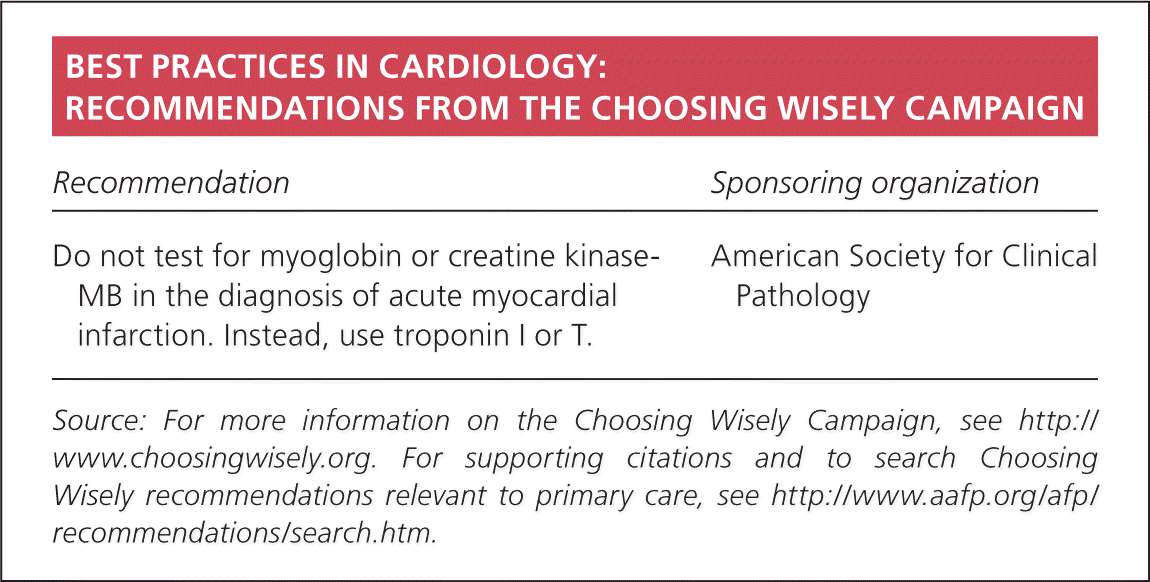
| Recommendation | Sponsoring organization |
|---|---|
| Do not test for myoglobin or creatine kinase-MB in the diagnosis of acute myocardial infarction. Instead, use troponin I or T. | American Society for Clinical Pathology |
| Clinical recommendation | Evidence rating | References |
|---|---|---|
| Reperfusion therapy, preferably primary PCI, should be administered to eligible patients with STEMI and symptom onset within the previous 12 hours. | A | 4 |
| In the absence of contraindications, fibrinolytic therapy should be administered to patients with STEMI at non–PCI-capable hospitals when the anticipated first medical contact to device time at a PCI-capable hospital exceeds 120 minutes. | A | 4 |
| Patients with STEMI should be transferred to a PCI-capable hospital for angiography after successful fibrinolysis. | B | 4 |
| Fibrinolysis is not recommended for treatment in patients with NSTE-ACS. | B | 5 |
| Parenteral anticoagulation, in addition to antiplatelet therapy, is recommended for all patients with NSTE-ACS regardless of initial treatment strategy. | A | 5 |
As of 2010, more than 625,000 patients were discharged from U.S. hospitals each year with an ACS diagnosis.2 The GRACE study found that approximately 30% of patients with ACS had STEMI, whereas 70% had a type of NSTE-ACS.3 The average age at first myocardial infarction (MI) is 65 years in men and 72 years in women.2 Although evidence shows decreased rates of hospitalization and mortality in patients receiving appropriate treatment, ACS continues to be the most common cause of death in the United States.1 This article focuses on the treatment of ACS based on the 2013 American College of Cardiology Foundation (ACCF) /AHA guideline for the management of STEMI 4 and the 2014 ACC/AHA guideline for the management of NSTE-ACS.5
Primary Prevention
The ACC/AHA guidelines continue to emphasize the importance of primary prevention of ACS by decreasing coronary artery disease risk factors, including hypertension, hypercholesterolemia, diabetes mellitus, and smoking.1 Family history of coronary artery disease is also a risk factor. There are several risk calculators available, most notably the Framingham risk score and, more recently, Pooled Cohort Equations for atherosclerotic cardiovascular disease.6 The atherosclerotic cardiovascular disease risk estimator is available online and in mobile app format at http://my.americanheart.org/cvrisk calculator and at http://www.cardiosource.org/en/Science-And-Quality/Practice-Guidelines-and-Quality-Standards/2013-Prevention-Guideline-Tools.aspx. However, this calculator has been criticized for overestimating the risk of cardiovascular disease in adults without diabetes.7
Family physicians should continue to educate patients about the risk factors, clinical presentation, and symptoms of ACS. Older persons, persons with diabetes, women, and postoperative patients should be aware that they may have atypical symptoms and presentation for ACS. At-risk patients should be regularly advised to seek medical care immediately if any atypical symptoms occur.1
Initial Management
At the individual level, patients should be advised to chew a nonenteric coated aspirin (162 to 325 mg) at first recognition of ACS symptoms, unless they have a history of severe aspirin sensitivity.4 At the community level, local areas should create and maintain emergency medical service systems that support STEMI care. Initial care should include a full assessment of clinical symptoms and coronary artery disease risk factors, as well as 12-lead electrocardiography. Electrocardiographic findings that may reflect myocardial ischemia include changes in the PR segment, QRS complex, and the ST segment.1 Part of the initial assessment also involves obtaining cardiac biomarkers that include troponin (I or T). Primary percutaneous coronary intervention (PCI) is the recommended reperfusion method; therefore, all efforts should be made to transfer a patient with suspected STEMI to a PCI-capable hospital. If none is available within a 30-minute travel time, medical management should occur in the nearest emergency department. The goal of medical management is to administer fibrinolytic therapy within 30 minutes of first medical contact.4
Medical Management
Table 1 summarizes the medications used to manage ACS.4,5 Dual antiplatelet therapy is highly recommended in the treatment of STEMI to support primary PCI and fibrinolytic treatment strategies. With either strategy, aspirin therapy (162 to 325 mg per day) should be started as soon as possible and continued indefinitely.4 For patients undergoing primary PCI for STEMI, a P2Y12 receptor antagonist, such as clopidogrel (Plavix; 600 mg), should be administered as early as possible or at the time of PCI, and a maintenance dosage of 75 mg per day should be continued for one year in patients who receive a stent. Patients undergoing fibrinolysis for STEMI should receive a loading dose of clopidogrel (300 mg in persons younger than 75 years, or 75 mg in persons 75 years and older) before treatment. Clopidogrel, 75 mg per day, should be continued in patients receiving fibrinolytic treatment for at least 14 days and up to one year. Glycoprotein IIb/IIIa inhibitors (such as tirofiban [Aggrastat], eptifibatide [Integrilin], and abciximab [Reopro]) have shown benefit when used during PCI in persons with STEMI and as an adjunct to PCI in persons with NSTE-ACS; however, triple antiplatelet therapy has been associated with an increased risk of bleeding.1
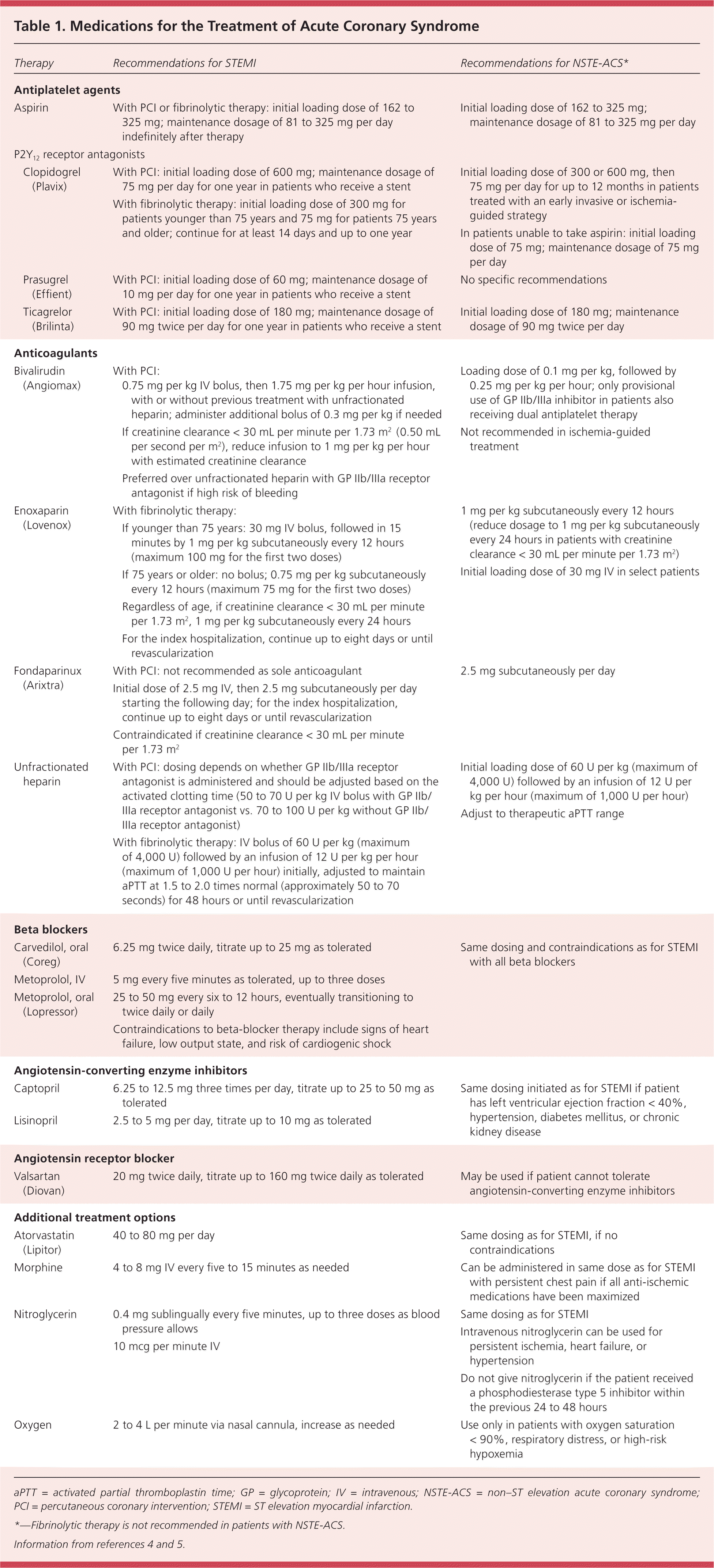
| Therapy | Recommendations for STEMI | Recommendations for NSTE-ACS* | |
|---|---|---|---|
| Antiplatelet agents | |||
| Aspirin | With PCI or fibrinolytic therapy: initial loading dose of 162 to 325 mg; maintenance dosage of 81 to 325 mg per day indefinitely after therapy | Initial loading dose of 162 to 325 mg; maintenance dosage of 81 to 325 mg per day | |
| P2Y12 receptor antagonists | |||
| Clopidogrel (Plavix) | With PCI: initial loading dose of 600 mg; maintenance dosage of 75 mg per day for one year in patients who receive a stent | Initial loading dose of 300 or 600 mg, then 75 mg per day for up to 12 months in patients treated with an early invasive or ischemia-guided strategy | |
| With fibrinolytic therapy: initial loading dose of 300 mg for patients younger than 75 years and 75 mg for patients 75 years and older; continue for at least 14 days and up to one year | In patients unable to take aspirin: initial loading dose of 75 mg; maintenance dosage of 75 mg per day | ||
| Prasugrel (Effient) | With PCI: initial loading dose of 60 mg; maintenance dosage of 10 mg per day for one year in patients who receive a stent | No specific recommendations | |
| Ticagrelor (Brilinta) | With PCI: initial loading dose of 180 mg; maintenance dosage of 90 mg twice per day for one year in patients who receive a stent | Initial loading dose of 180 mg; maintenance dosage of 90 mg twice per day | |
| Anticoagulants | |||
| Bivalirudin (Angiomax) | With PCI:
| Loading dose of 0.1 mg per kg, followed by 0.25 mg per kg per hour; only provisional use of GP IIb/IIIa inhibitor in patients also receiving dual antiplatelet therapy Not recommended in ischemia-guided treatment | |
| Enoxaparin (Lovenox) | With fibrinolytic therapy:
| 1 mg per kg subcutaneously every 12 hours (reduce dosage to 1 mg per kg subcutaneously every 24 hours in patients with creatinine clearance < 30 mL per minute per 1.73 m2) Initial loading dose of 30 mg IV in select patients | |
| Fondaparinux (Arixtra) | With PCI: not recommended as sole anticoagulant | 2.5 mg subcutaneously per day | |
| Initial dose of 2.5 mg IV, then 2.5 mg subcutaneously per day starting the following day; for the index hospitalization, continue up to eight days or until revascularization | |||
| Contraindicated if creatinine clearance < 30 mL per minute per 1.73 m2 | |||
| Unfractionated heparin | With PCI: dosing depends on whether GP IIb/IIIa receptor antagonist is administered and should be adjusted based on the activated clotting time (50 to 70 U per kg IV bolus with GP IIb/IIIa receptor antagonist vs. 70 to 100 U per kg without GP IIb/IIIa receptor antagonist) | Initial loading dose of 60 U per kg (maximum of 4,000 U) followed by an infusion of 12 U per kg per hour (maximum of 1,000 U per hour) | |
| With fibrinolytic therapy: IV bolus of 60 U per kg (maximumof 4,000 U) followed by an infusion of 12 U per kg per hour (maximum of 1,000 U per hour) initially, adjusted to maintain aPTT at 1.5 to 2.0 times normal (approximately 50 to 70 seconds) for 48 hours or until revascularization | Adjust to therapeutic aPTT range | ||
| Beta blockers | |||
| Carvedilol, oral (Coreg) | 6.25 mg twice daily, titrate up to 25 mg as tolerated | Same dosing and contraindications as for STEMI with all beta blockers | |
| Metoprolol, IV | 5 mg every five minutes as tolerated, up to three doses | ||
| Metoprolol, oral (Lopressor) | 25 to 50 mg every six to 12 hours, eventually transitioning to twice daily or daily | ||
| Contraindications to beta-blocker therapy include signs of heart failure, low output state, and risk of cardiogenic shock | |||
| Angiotensin-converting enzyme inhibitors | |||
| Captopril | 6.25 to 12.5 mg three times per day, titrate up to 25 to 50 mg as tolerated | Same dosing initiated as for STEMI if patient has left ventricular ejection fraction < 40%, hypertension, diabetes mellitus, or chronic kidney disease | |
| Lisinopril | 2.5 to 5 mg per day, titrate up to 10 mg as tolerated | ||
| Angiotensin receptor blocker | |||
| Valsartan (Diovan) | 20 mg twice daily, titrate up to 160 mg twice daily as tolerated | May be used if patient cannot tolerate angiotensin-converting enzyme inhibitors | |
| Additional treatment options | |||
| Atorvastatin (Lipitor) | 40 to 80 mg per day | Same dosing as for STEMI, if no contraindications | |
| Morphine | 4 to 8 mg IV every five to 15 minutes as needed | Can be administered in same dose as for STEMI with persistent chest pain if all anti-ischemic medications have been maximized | |
| Nitroglycerin | 0.4 mg sublingually every five minutes, up to three doses as blood pressure allows | Same dosing as for STEMI | |
| 10 mcg per minute IV | Intravenous nitroglycerin can be used for persistent ischemia, heart failure, or hypertension | ||
| Do not give nitroglycerin if the patient received a phosphodiesterase type 5 inhibitor within the previous 24 to 48 hours | |||
| Oxygen | 2 to 4 L per minute via nasal cannula, increase as needed | Use only in patients with oxygen saturation < 90%, respiratory distress, or high-risk hypoxemia | |
Anticoagulation therapy should also be initiated with either PCI or fibrinolytic therapy for the treatment of STEMI. For patients undergoing PCI, unfractionated heparin should be administered to maintain a therapeutic activated clotting time level. Bivalirudin (Angiomax) is an option, even with previous use of unfractionated heparin. Fondaparinux (Arixtra) should not be used as sole anticoagulation therapy in patients undergoing PCI because of the risk of catheter thrombosis.4 For patients receiving fibrinolytic therapy for STEMI, unfractionated heparin, enoxaparin (Lovenox), or fondaparinux can be used. Treatment should be given for a minimum of 48 hours and up to eight days.
Additional acute treatment options include supplemental oxygen, nitroglycerin, intravenous morphine, beta blockers, angiotensin-converting enzyme inhibitors or angiotensin receptor blockers, and statins. These medications may be used for STEMI or NSTE-ACS, but with a few slight differences as outlined in Table 1.4,5 There are limited data to support or refute the routine use of supplemental oxygen in the acute phase of management.4 Oxygen supplementation may increase coronary vascular resistance, although it may be appropriate in patients with oxygen saturation less than 90%. Morphine continues to be the medication of choice for pain relief in patients with STEMI; however, it should be used in patients with NSTE-ACS only if anti-ischemic therapy has been maximized and chest pain persists. Beta blockers should be started within 24 hours in patients with STEMI or NSTE-ACS who do not have signs of heart failure, evidence of low output state, increased risk of cardiogenic shock, or other contraindications. Angiotensin-converting enzyme inhibitors should be administered within the first 24 hours to all patients with heart failure, STEMI with anterior location, or ejection fraction less than 40%, in the absence of contraindications to therapy. Continuing or initiating high-intensity statin therapy is recommended, even in patients with baseline low-density lipoprotein cholesterol levels less than 70 mg per dL (1.81 mmol per L).
Reperfusion Therapy
After STEMI has been identified, the most appropriate strategy for reperfusion should be determined quickly. Reperfusion therapy should be administered to eligible patients with STEMI and symptom onset within the previous 12 hours.4 Figure 1 summarizes the elements involved in developing a treatment strategy for patients with STEMI.4 Prompt restoration of flow in an occluded artery is the most important factor in defining short- and long-term outcome, regardless of the method.4 Primary PCI leads to improved outcomes compared with fibrinolysis when performed in high-volume medical facilities without treatment delays. However, this comparative benefit is lost if treatment is delayed, which may occur if a patient's first medical contact is at a non–PCI-capable facility. Thus, emphasis should be placed on rapid reperfusion, regardless of strategy. In patients with STEMI who undergo PCI, the recommended goals for first medical contact to device time are 90 minutes for persons presenting to a PCI-capable hospital and 120 minutes for those presenting to a non–PCI-capable facility.4
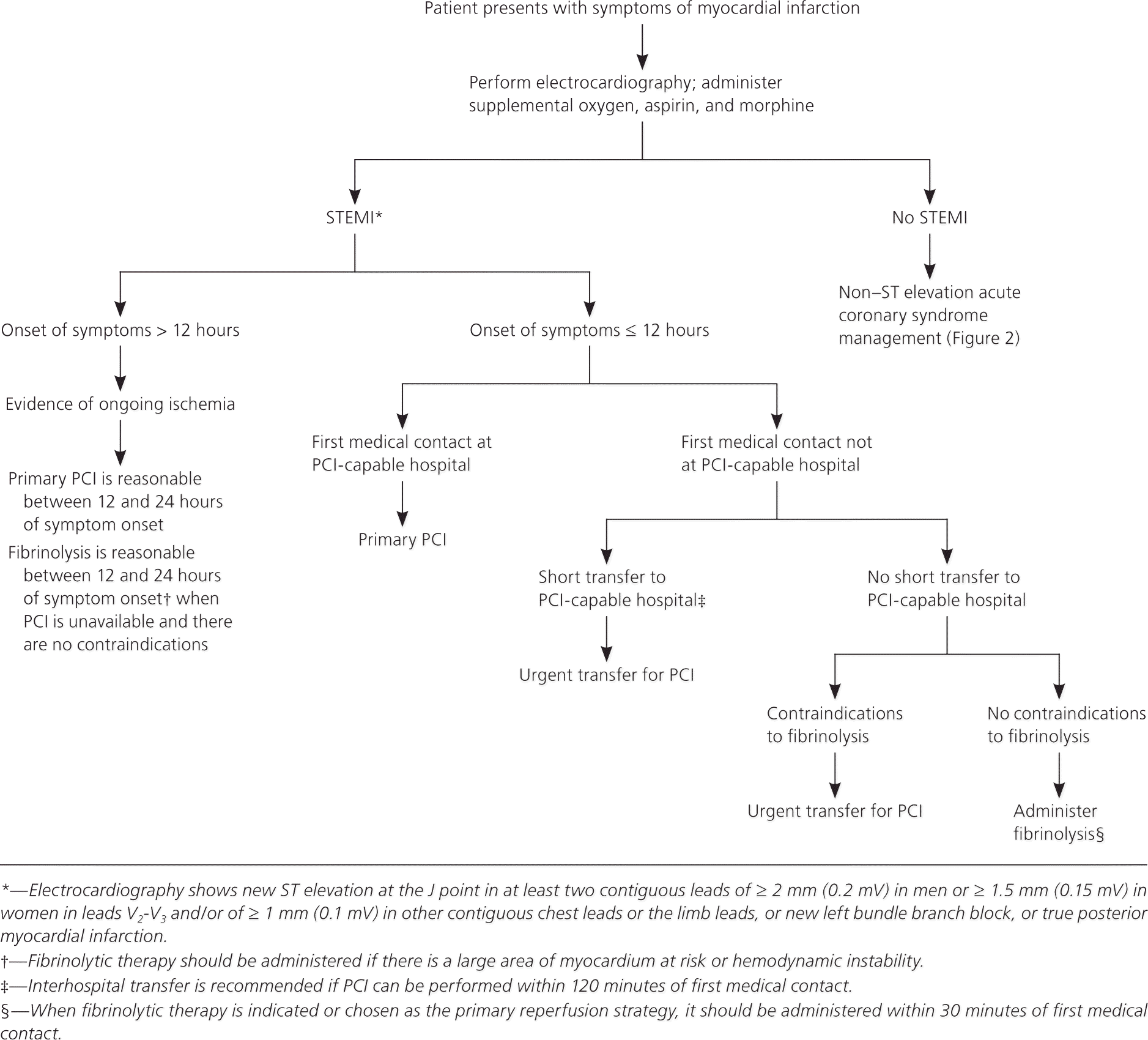
PCI is considered the primary method of reperfusion, unless the patient has an absolute contraindication. If the first medical contact is at a non–PCI-capable hospital, selecting a reperfusion strategy requires consideration of multiple factors, including the time required for transfer, the time since symptom onset, the risk of complications from STEMI, the risk of bleeding with fibrinolysis, and the presence of shock or heart failure.4 Special consideration should be given to women with STEMI, because they have shown an improved response with PCI compared with fibrinolysis.8
Fibrinolytic therapy is the next best option. In the absence of contraindications, it should be administered to patients with STEMI at non–PCI-capable hospitals if the anticipated first medical contact to device time at a PCI-capable hospital exceeds 120 minutes.4 Table 2 lists absolute and relative contraindications for fibrinolytic therapy.4 The ACCF/AHA guideline recommends using a fibrin-specific fibrinolytic agent. Table 3 lists fibrinolytic agents currently available; those agents available in the United States are all considered fibrin-specific.4
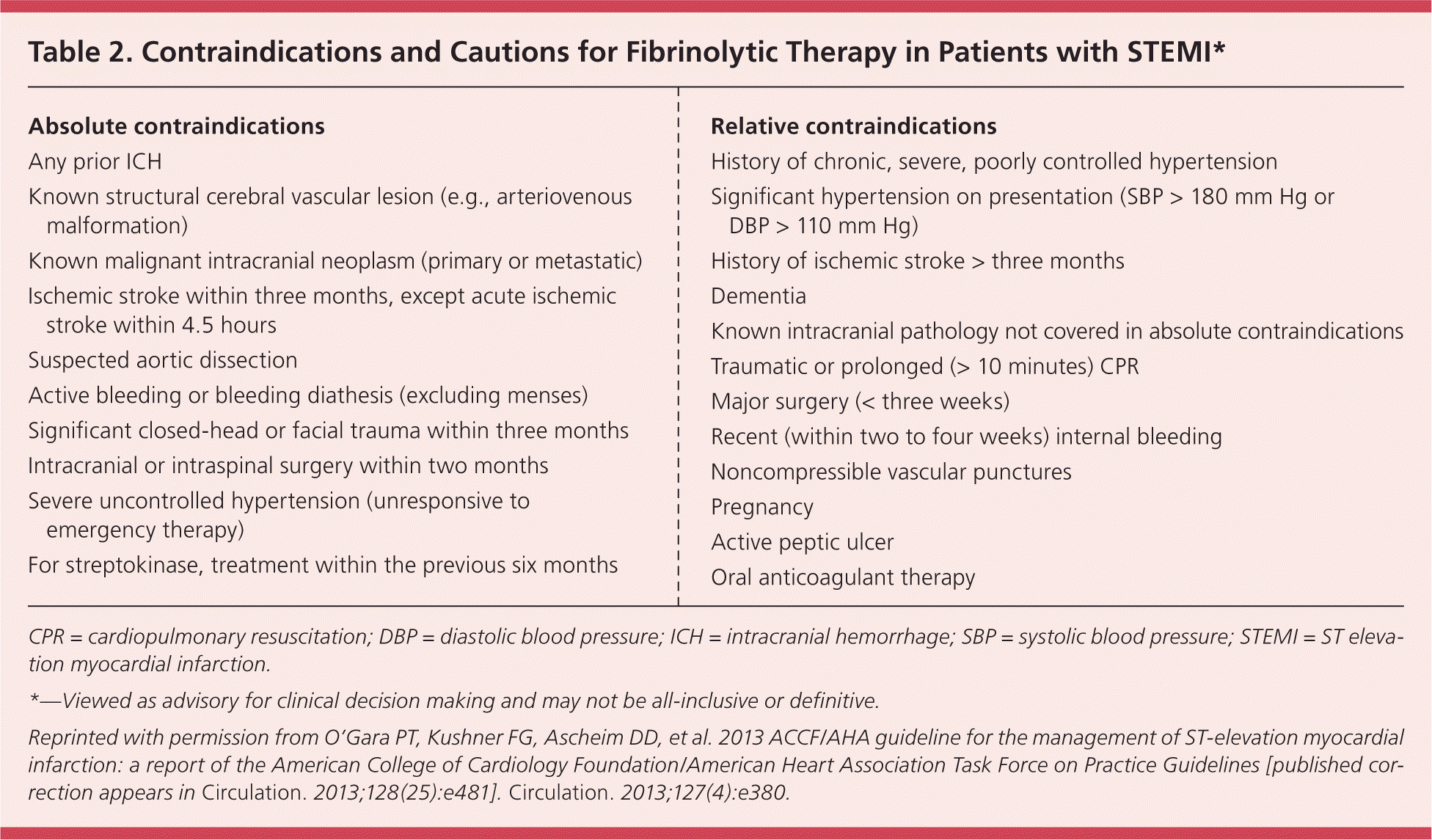
| Absolute contraindications |
| Any prior ICH |
| Known structural cerebral vascular lesion (e.g., arteriovenous malformation) |
| Known malignant intracranial neoplasm (primary or metastatic) |
| Ischemic stroke within three months, except acute ischemic stroke within 4.5 hours |
| Suspected aortic dissection |
| Active bleeding or bleeding diathesis (excluding menses) |
| Significant closed-head or facial trauma within three months |
| Intracranial or intraspinal surgery within two months |
| Severe uncontrolled hypertension (unresponsive to emergency therapy) |
| For streptokinase, treatment within the previous six months |
| Relative contraindications |
| History of chronic, severe, poorly controlled hypertension |
| Significant hypertension on presentation (SBP > 180 mm Hg or DBP > 110 mm Hg) |
| History of ischemic stroke > three months |
| Dementia |
| Known intracranial pathology not covered in absolute contraindications |
| Traumatic or prolonged (> 10 minutes) CPR |
| Major surgery (< three weeks) |
| Recent (within two to four weeks) internal bleeding |
| Noncompressible vascular punctures |
| Pregnancy |
| Active peptic ulcer |
| Oral anticoagulant therapy |
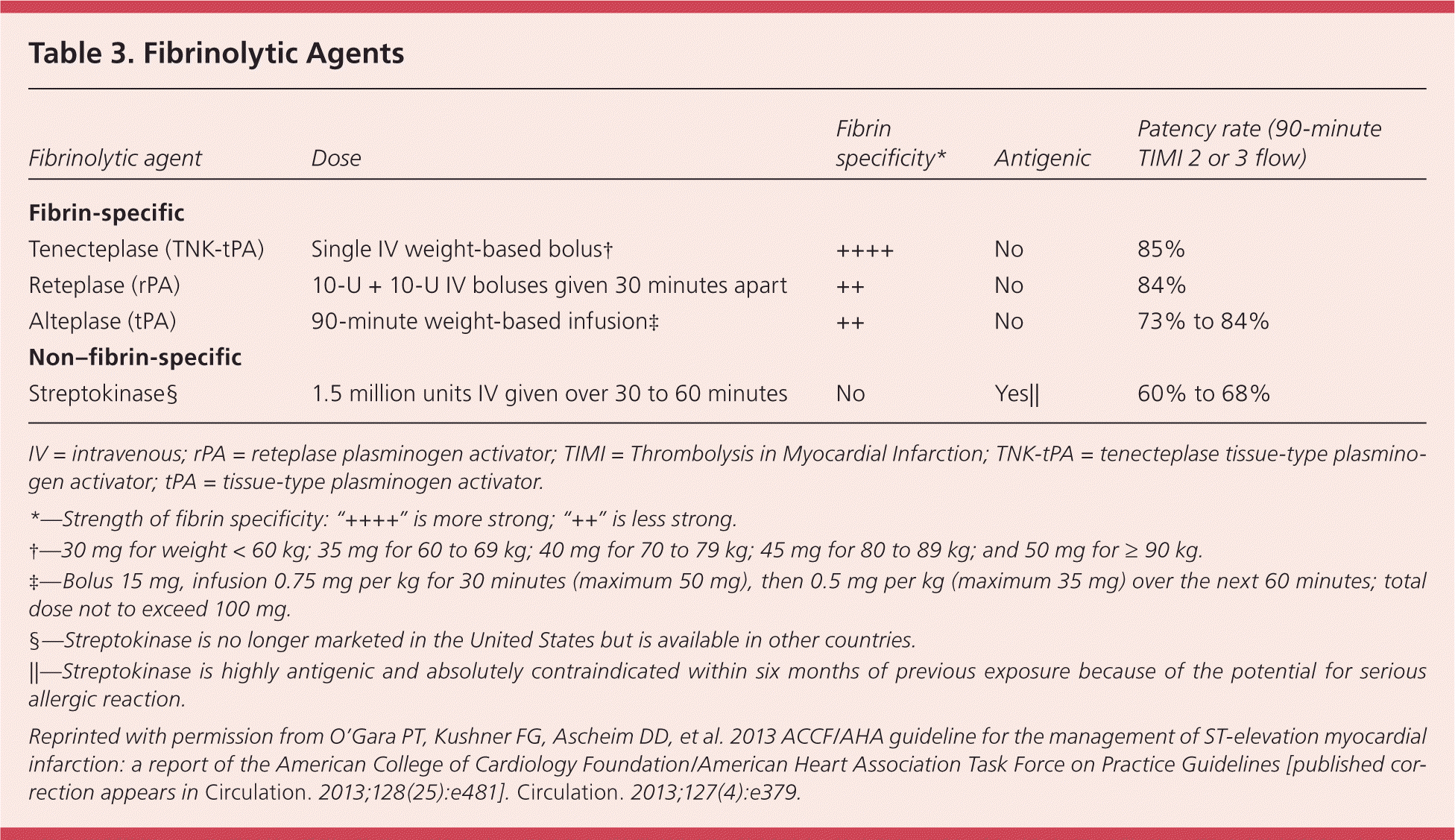
| Fibrinolytic agent | Dose | Fibrin specificity* | Antigenic | Patency rate (90-minute TIMI 2 or 3 flow) |
|---|---|---|---|---|
| Fibrin-specific | ||||
| Tenecteplase (TNK-tPA) | Single IV weight-based bolus† | ++++ | No | 85% |
| Reteplase (rPA) | 10-U + 10-U IV boluses given 30 minutes apart | ++ | No | 84% |
| Alteplase (tPA) | 90-minute weight-based infusion‡ | ++ | No | 73% to 84% |
| Non–fibrin-specific | ||||
| Streptokinase§ | 1.5 million units IV given over 30 to 60 minutes | No | Yes|| | 60% to 68% |
Transfer to a PCI-capable hospital for angiography is recommended for all patients with STEMI after fibrinolysis, although the urgency of transfer depends on the patient's clinical status. Immediate transfer is recommended for patients who develop cardiogenic shock or acute severe heart failure after fibrinolysis.4 Even in the absence of shock or heart failure in patients with evidence of failed reperfusion or reocclusion, urgent transfer for angiography is recommended. Evidence of failed reperfusion includes lack of resolution of ST elevation and persistent or recurrent chest pain. Routine transfer to a PCI-capable hospital for angiography after successful fibrinolysis has been shown to improve outcomes in multiple trials and is recommended, ideally within 24 hours of fibrinolysis.4,9–12
NSTE-ACS VS. STEMI
Treatment of NSTE-ACS is similar to that of STEMI (Figure 2).5 Patients can be categorized by risk factors and clinical stability into early invasive or ischemia-guided strategies. An early invasive strategy—diagnostic angiography followed by revascularization (primarily with PCI), as appropriate—is indicated for stabilized patients who are at high risk of coronary events, whereas an ischemia-guided approach is indicated for stabilized patients with lower risk scores and is based on patient and physician preferences. Current guidelines recommend against the use of fibrinolytic agents in patients with NSTE-ACS because of an increased risk of reinfarction and other complications.5 Table 4 lists factors to help select a treatment strategy.5
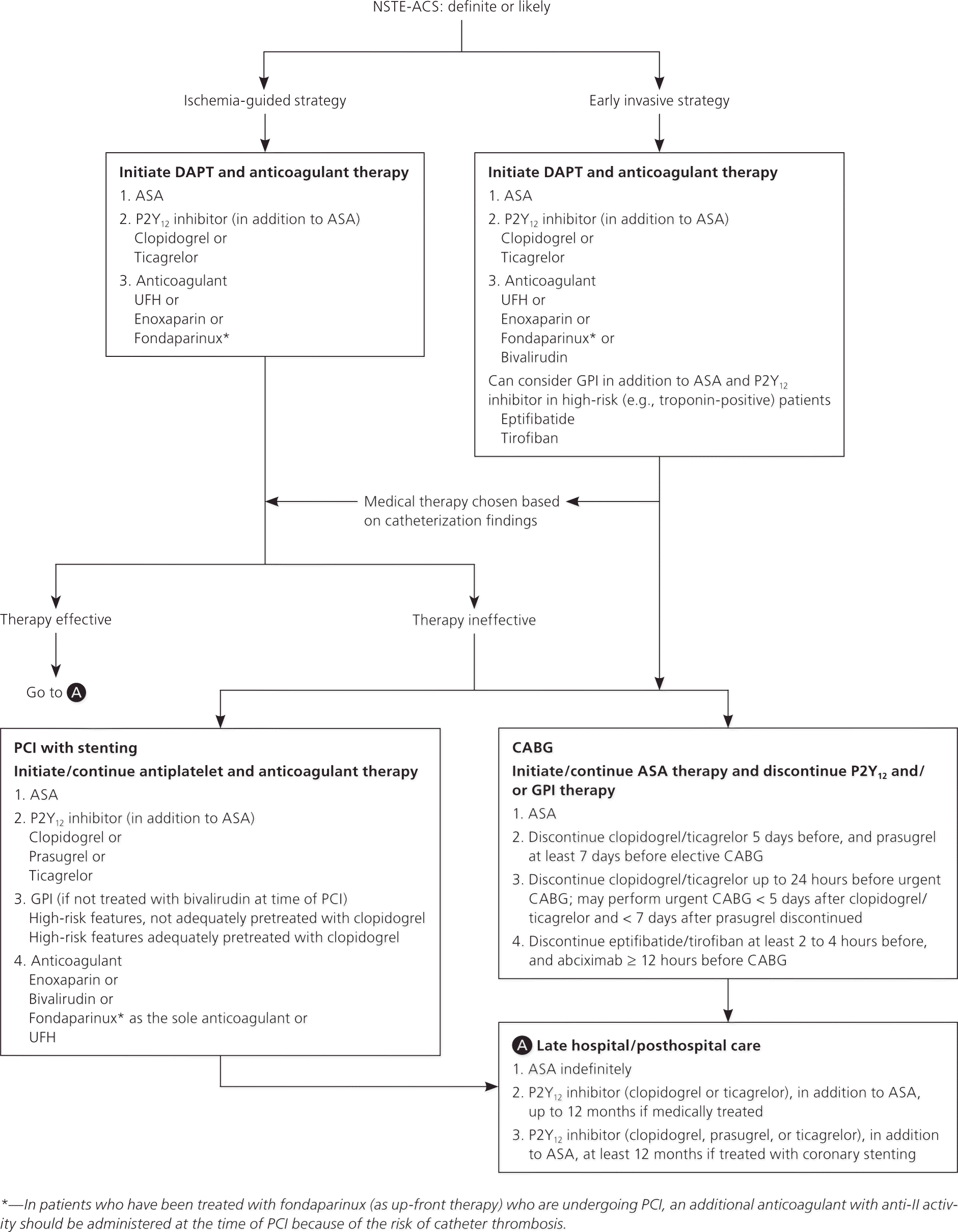
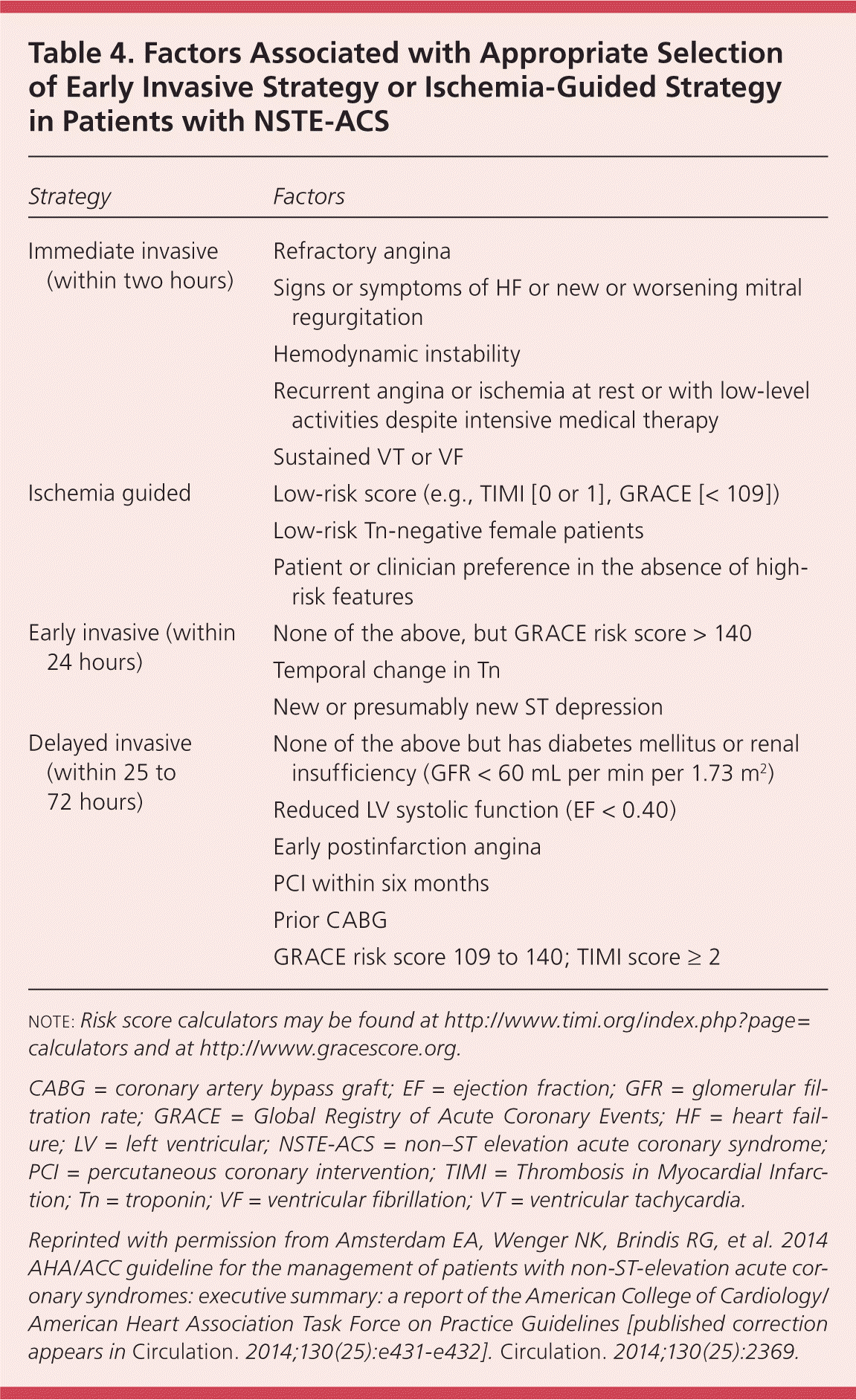
| Strategy | Factors |
|---|---|
| Immediate invasive (within two hours) | Refractory angina |
| Signs or symptoms of HF or new or worsening mitral regurgitation | |
| Hemodynamic instability | |
| Recurrent angina or ischemia at rest or with low-level activities despite intensive medical therapy | |
| Sustained VT or VF | |
| Ischemia guided | Low-risk score (e.g., TIMI [0 or 1], GRACE [< 109]) |
| Low-risk Tn-negative female patients | |
| Patient or clinician preference in the absence of high-risk features | |
| Early invasive (within 24 hours) | None of the above, but GRACE risk score > 140 |
| Temporal change in Tn | |
| New or presumably new ST depression | |
| Delayed invasive (within 25 to 72 hours) | None of the above but has diabetes mellitus or renal insufficiency (GFR < 60 mL per min per 1.73 m2) |
| Reduced LV systolic function (EF < 0.40) | |
| Early postinfarction angina | |
| PCI within six months | |
| Prior CABG | |
| GRACE risk score 109 to 140; TIMI score ≥ 2 |
Patients with NSTE-ACS tend to be older and have more comorbidities than patients with STEMI, thus a more conservative approach is often appropriate.13 It is recommended that most patients with NSTE-ACS receive dual antiplatelet therapy with aspirin and a P2Y12 inhibitor, such as clopidogrel, regardless of whether they are undergoing an early invasive or ischemia-guided approach.5 Parenteral anticoagulation therapy is also recommended regardless of treatment strategy. The same agents and dosing regimens described for the treatment of STEMI apply to the treatment of NSTE-ACS, although bivalirudin is not recommended in ischemia-guided treatment. If an ischemia-guided strategy is selected, the patient should be monitored closely for responsiveness to therapy. Transition to invasive management, which includes angiography with PCI or coronary artery bypass graft, may be necessary in patients who do not respond to therapy.
Prognosis and Secondary Prevention
Patients who survive a first MI are at an increased risk of future cardiovascular events. Studies have shown that up to one-half of patients do not receive one or more recommended treatments during an ACS event.14 In general, the short-term mortality rate at 30 days after an ACS event is between 2% and 3%; the mortality rate is lower after an NSTE-ACS event than after STEMI.15 Rehospitalization within 30 days ranges between 17% and 25% for all types of ACS.16 The risk of sudden cardiac death increases after an ACS, and is correlated with low ejection fraction (35% or less). Mortality rates at one year begin to equalize between patients with STEMI and NSTE-ACS at approximately 8% to 10%, with long-term mortality rates higher in patients with NSTE-ACS.17,18 This is believed to be secondary to the older age and increased comorbidities in patients with NSTE-ACS.19
The key to reducing the risk of morbidity and mortality is a secondary prevention plan, which should be closely coordinated with the patient's cardiologist.20 Specific recommendations for posthospitalization care include a cardiac rehabilitation program, an evidence-based plan of care that includes medication management and timely follow-up, and strategies to control risk factors, such as cholesterol levels, hypertension, and smoking.4
Data Sources: Essential Evidence Plus, provided by AFP, was used in writing this manuscript. Databases searched include PubMed, Ovid, SP, Google Scholar, and Cochrane database. Keywords used include (with combinations using Booleans OR and AND): myocardial infarction, STEMI, NSTEMI, prognosis, fibrinolysis, percutaneous coronary intervention, acute coronary syndrome guidelines, and heart disease. Search dates: July 15, August 2, and September 18, 2015, and February 3, 2016.
The views expressed in this article are those of the authors and do not necessarily reflect the official policy of the Department of Defense, the Department of the Army, the U.S. Army Medical Department, or the U.S. government.
